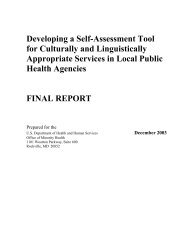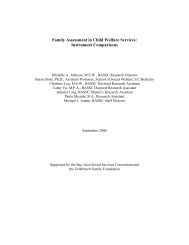Barbara Needell, Principal Investigator Stephanie Cuccaro-Alamin ...
Barbara Needell, Principal Investigator Stephanie Cuccaro-Alamin ...
Barbara Needell, Principal Investigator Stephanie Cuccaro-Alamin ...
- No tags were found...
You also want an ePaper? Increase the reach of your titles
YUMPU automatically turns print PDFs into web optimized ePapers that Google loves.
YOUTH EMANCIPATING FROM FOSTER CARE IN CALIFORNIA:FINDINGS USING LINKED ADMINISTRATIVE DATAEXECUTIVE SUMMARY<strong>Barbara</strong> <strong>Needell</strong>, <strong>Principal</strong> <strong>Investigator</strong><strong>Stephanie</strong> <strong>Cuccaro</strong>-<strong>Alamin</strong>Alan BrookhartWilliam JackmanAron ShlonskyCenter for Social Services ResearchUniversity of California at BerkeleyMay 2002
3It has been estimated that nearly 20,000 U.S. children emancipate from foster care eachyear (USDHHS, 1999). Previous research has indicated that these youth often face seriouschallenges as they enter the adult world. In December, 1999, then President Clinton signed intolaw the Foster Care Independence Act of 1999, (P.L. 106-109), which includes provisions toassist youth leaving foster care by offering better educational opportunities, access to health care,training, housing assistance, and other services (USDHHS, 1999).Foster care data had previously been reconfigured into longitudinal format at the Centerfor Social Services Research (CSSR) as part of the California Children’s Services Archive. 1Available social security numbers (SSNs) for emancipating youth were provided to seven stateagencies who may have served these youth, data were linked by the agencies, and linked datawere then provided to CSSR staff. Linkage to each of these administrative datasets is anindicator of an outcome. For example, emancipating youth whose records were linked to thestate prison database were considered to have entered prison; those for whom there was nolinkage were considered not to have entered prison. For some data, (MEDS, Mental Health,Vital Statistics), individual level data with identifiers were provided, allowing for analysis at thechild specific level. Individual level data were also provided regarding Community Collegeenrollment, but without identifiers and with some data suppressed due to small sample sizes.California Youth Authority data was also provided without identifiers. State prison and GEDdata were provided in the aggregate. All analyses were run separately for emancipating childwelfare (ECW) and emancipating probation (EPR) youth. In many cases, the sample of femaleEPR youth was too small for meaningful interpretation.Most of the existing research on emancipation from foster care uses interviews withformer foster youth. Only recently have administrative data been used as a tool to inform thisissue. The study reported here uses a sample of 12,306 youth who emancipated 2 from foster carein California between the years of 1992 and 1997.In summary:1. A substantial number of California youth are growing up in child welfaresupervised foster care, and many of these youth are having multiple placementswhile in care.2. Most youth in foster care receive some kind of mental health services. The mostcommon diagnosis for youth emancipating from the child welfare system was amood disorder, while the most common diagnosis for youth emancipating fromthe probation system was a behavior disorder. Youth placed with kin are lesslikely to receive mental health services than those in other placement types, andyouth in group homes are by far the most likely to receive mental health services.1 Data was derived from the Foster Care Information system (FCIS) database, supplied to CSSR through aninteragency agreement with the California Department of Social Services.2 Children who exited the foster care system with a reason for termination code of “Emancipation or Age ofMajority”, or who exited at age 19 or older with no termination reason given.
43. A substantial minority of young women is becoming pregnant in child welfareservices supervised foster care, or shortly after emancipation. However, the birthrate for 18 - 19 year old females who emancipate from the child welfare systemdoes not appear to be greater than the rate for other 18 - 19 year old females.4. Many emancipating females (apparently the majority of those who becomemothers) receive “welfare” after emancipation. They are about 4 times as likely toreceive “welfare” as other young females in the population.5. Although many youth make connections with the state’s community collegesystem, and many have laudable educational goals, few progress through thesystem.7. A small but disturbing proportion of males enter the state prison system after theyleave the child welfare system, and many males who emancipate from theprobation foster care system later enter the state prison system.The clearest consistent finding was that youth emancipating from the child welfaresystem who have had 5 or more placements were those who generally experienced the worstoutcomes, suggesting both the need for targeted services to youth with multiple placements, andcontinued effort to improve placement stability for youth in care. Further investigation isnecessary to better understand the association between multiple placements and the receipt ofmental health services. Multiple placements may be the cause and/or the effect of child specificproblems.Research that utilizes administrative data does have its limitations, and this study inparticular has weaknesses that must be mentioned. 3 The foster care data, drawn from California’snow defunct Foster Care Information System, 4 may contain errors, and there is missing data,particularly regarding type of placement. The other data sources may also contain errors or beincomplete. Only 93 percent of the youth in the sample had valid SSNs, and although it doesappear that this subsample is not particularly biased (see Tables 1 and 2), the use of morethorough probabilistic matching techniques may have improved the quality of the linkages.Therefore, linkages probably underestimate the number of true matches. Using only SSNsparticularly hampered the linkage to Vital Statistics data, as SSNs in the Vital Statistics databasewere only available from 1996 onwards. Current confidentiality agreements and privacyconcerns did not allow for individual level data for some of the linkages and suppression of cellsand or aggregation of data severely limited our ability to conduct certain analyses. GED and stateprison data were only provided in the aggregate, and cells were suppressed due to small samplesize in the community college data.Despite these limitations, this study makes a valuable contribution to the research onyouth who emancipate from foster care. Measurements that previously were poorly estimated3 CSSR was not involved in the design of this study4 CSSR now uses the Child Welfare Services/Case Management System (CWS/CMS) to continue the longitudinalfoster care database
through anecdote or non-representative samples have been produced in recent years for the entirepopulation of California’s emancipating youth. This study marks the first time these datahave been integrated and analyzed in California, representing an important initial step inmeasuring these crucial outcomes for youth who emancipate from out of home care.5
6REFERENCESAnnie E. Casey Foundation. (2000). Voices of youth: Supporting adolescents in foster care.Video. Baltimore, MA: Author. (see www.aecf.org)Barth, R. P. (1990). On their own: The experiences of youth after foster care. Child andAdolescent Social Work Journal, 7, 419-440.Courtney, M. E., Piliavin, I., Grogan-Kaylor, A., & Nesmith, A. (1998). Foster youth transitionsto adulthood: Outcomes 12 to 18 months after leaving out-of-home care. Madison, WI: Institutefor Research on Poverty.Dworsky, A. & Courtney, M.E. (2000). Self-sufficiency of former foster youth in Wisconsin:Analysis of unemployment insurance wage data and public assistance data. Office of theAssistant Secretary for Planning and Evaluation, USDHHS.http://aspe.hhs.gov/hsp/fosteryouthWI00/ (3/2/2001)Festinger, T. (1983). No one ever asked us: A postscript to foster care. New York: ColumbiaUniversity Press.Jones, M. & Moses, B. (1984). West Virginia's former foster children: Their experiences in careand their lives as young adults. New York: Child Welfare League of America.USDHHS (1999). President Clinton signs landmark law to help foster care youth prepare forindependent living. ACF Press Room http://www/acf.dhhs.gov/news/press/1999/fcia.htm.(connected 3/3/2001)
















